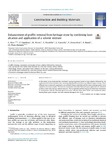| dc.contributor.author | Ricci, Chiara | |
| dc.contributor.author | Gambino, Francesca | |
| dc.contributor.author | Nervo, Marco | |
| dc.contributor.author | Piccirillo, Anna | |
| dc.contributor.author | Scarcella, Arianna | |
| dc.contributor.author | Zenucchini, Francesca | |
| dc.contributor.author | Ramil, Alberto | |
| dc.contributor.author | Pozo Antonio, José Santiago | |
| dc.date.accessioned | 2024-02-08T11:52:58Z | |
| dc.date.available | 2024-02-08T11:52:58Z | |
| dc.date.issued | 2020-11 | |
| dc.identifier.citation | Ricci C, Gambino F, Nervo M, Piccirillo A, Scarcella A, Zenucchini F, et al. Enhancement of graffiti removal from heritage stone by combining laser ablation and application of a solvent mixture. Construction and Building Materials 2020;262:119934. https://doi.org/10.1016/j.conbuildmat.2020.119934 | es_ES |
| dc.identifier.issn | 1879-0526 | |
| dc.identifier.uri | http://hdl.handle.net/2183/35515 | |
| dc.description.abstract | [Abstract] In this study, it was evaluated the combined cleaning treatment based on laser ablation followed by the application of chemical products for removing alkyd graffiti paint from two different types of stone. Three different laser treatments (operated in Q-switched, long Q-switched and free short running modes) were applied to the stone samples. The best two treatments were then followed up by application of a chemical product (a low toxic ternary solvent mixture). The Q-switched and the long Q-switched laser treatments in combination with the chemical agent were more effective than either of the laser treatments alone, leaving fewer paint remains, but with minimal damage to the stone. | es_ES |
| dc.description.sponsorship | C. Ricci was supported by the “Degrado Urbano” project of Fondazione Centro Conservazione e Restauro “La Venaria Reale” (Turin, Italy), funded by the “Compagnia di San Paolo”. J.S. Pozo-Antonio was supported by the Ministry of Economy and Competitiveness, Government of Spain, through grant number IJCI-2017-32771. The authors thank A. De Stefanis (Fondazione Centro Conservazione e Restauro “La Venaria Reale”) for help with conducting the cleaning tests. This research was performed within the framework of the teaching innovation group ODS Cities and Citizenship of University of Vigo (Spain). | es_ES |
| dc.language.iso | eng | es_ES |
| dc.publisher | Elsevier | es_ES |
| dc.relation | info:eu-repo/grantAgreement/MICINN/Plan Estatal de Investigación Científica y Técnica y de Innovación 2013- 2016/IJCI-2017-32771/ES | es_ES |
| dc.relation.uri | https://doi.org/10.1016/j.conbuildmat.2020.119934 | es_ES |
| dc.subject | Architectural heritage | es_ES |
| dc.subject | Chemical cleaning | es_ES |
| dc.subject | Graffiti paint | es_ES |
| dc.subject | Laser | es_ES |
| dc.subject | Cleaning effectiveness | es_ES |
| dc.subject | Gneiss | es_ES |
| dc.subject | Travertine | es_ES |
| dc.title | Enhancement of graffiti removal from heritage stone by combining laser ablation and application of a solvent mixture | es_ES |
| dc.type | info:eu-repo/semantics/article | es_ES |
| dc.rights.access | info:eu-repo/semantics/openAccess | es_ES |
| dc.date.embargoEndDate | 9999-99-99 | |
| dc.date.embargoLift | 9999-99-99 | |
| UDC.journalTitle | Construction and Building Materials | es_ES |
| UDC.volume | 202 | es_ES |
| UDC.startPage | 1 | es_ES |
| UDC.endPage | 14 | es_ES |
| dc.identifier.doi | https://doi.org/10.1016/j.conbuildmat.2020.119934 | |






